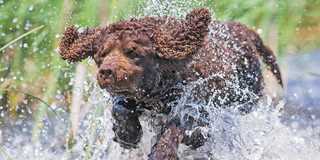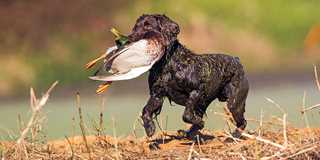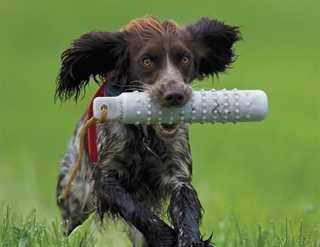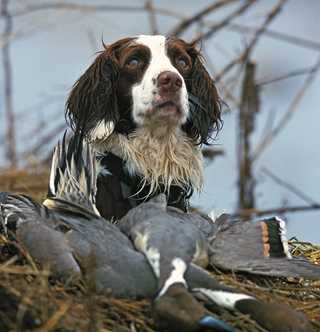The Spaniels
These retrievers offer full-size performance in a pint-size package
These retrievers offer full-size performance in a pint-size package

The Labrador retriever, the golden retriever, and the Chesapeake Bay retriever are the big-three dog breeds of the waterfowling world, but they're far from being the only ones capable of performing successfully in the wet stuff. If you're looking for a smaller retriever, and you're willing to work around their limitations, these members of the spaniel clan might be just what the doctor ordered.

Photo UPCLOSEPHOTO.COM
The American water spaniel was the market hunter's dog of choice in Wisconsin's Fox-Wolf watershed more than a century ago. For today's waterfowler who wants a smaller dog that excels in the water, this breed is a solid choice. "They're bred to be water dogs," notes Tim Otto, a Wisconsin conservation warden who hunts waterfowl and upland game with his spaniel. "They're tolerant of cold water thanks to their double coat, and they have a very high prey drive. Even when it's slow, my dog will sit in the boat for hours and never lose focus."
Otto acknowledges that the breed can be a challenge to train. "You have to try to stay one step ahead of them," he says. But the potential rewards make it worth the effort. "For any waterfowling role that calls for a smaller dog, the American water spaniel is fantastic."

Photo UPCLOSEPHOTO.COM
Legend has it that the Boykin spaniel's origins can be traced to a little brown dog found wandering the streets of Spartanburg, South Carolina, circa 1909. Originally developed to hunt ducks out of small take-apart craft known as "section boats," Boykins have a devoted following among dove hunters due to their outstanding heat tolerance. They are indefatigable retrievers in water and on land.
Ohio sportsman Eric Hicks hunts his trio of Boykins 60 to 80 days a year. "With the exception of handling really cold water," he says, "they'll do anything a Lab can do. I do a lot of cornfield hunting from layout blinds, and my Boykins stay quietly in place until I give them the release command. Then they're off like a shot." Hicks cautions that while Boykins may rival Labs in terms of performance, they can't take the kind of pressure, and especially the repetition, that Labs can. When you're training a Boykin, less is typically more.

Photo TONYZAPPIA.COM
The English cocker's stock as a working gun dog has soared in the past 25 years. For duck hunters, the upside is the breed's natural retrieving ability. "The cockers that came here in the 1970s and 80s and laid the foundation for the breed in America were very strong retrievers, and they passed on this quality to their descendants," explains North Dakota trainer Tom Ness. "They're good markers, they love the water, and they're fast. I don't think there's another breed that can get to a fall as quickly as a cocker can."
The downside is that the cocker's silky coat absorbs water, making it less than ideal for hunting in cold conditions. A neoprene vest helps, but only to a point. The cocker's small sizebetween 20 and 30 poundscan be a liability in some situations as well. Still, for jump-shooting out of a canoe, easing along a creek bottom hoping to surprise some woodies, or mucking a marsh edge, alert to whatever flushes in range, a cocker is hard to beat.

IMAGESONTHEWILDSIDE.COM
Photo DENVER BRYAN
Texas-based dog trainer David Jones likes to tell of the time he took two of his springer spaniels on a snow goose hunt. "The guide was skeptical," Jones recalls, "but I persuaded him that my dogs were pretty well trained. When the hunt was over, they'd retrieved 37 snow geese. The guide came up to me and asked, 'Where do I get a springer?'"
Jones argues that the breed's strength is its versatility. "It's a true multipurpose dog," he says. "You can hunt doves with a springer, you can hunt ducks and geese, pheasantseverything. A smaller springer may have a hard time with a big Canada goose, but it'll get the job done eventually. They handle cold water surprisingly well if you outfit them with a neoprene vest, and the vast majority of retrieving situations are well within their capabilities."
Ducks Unlimited uses cookies to enhance your browsing experience, optimize site functionality, analyze traffic, and deliver personalized advertising through third parties. By continuing to use this site, you agree to our use of cookies. View Privacy Policy